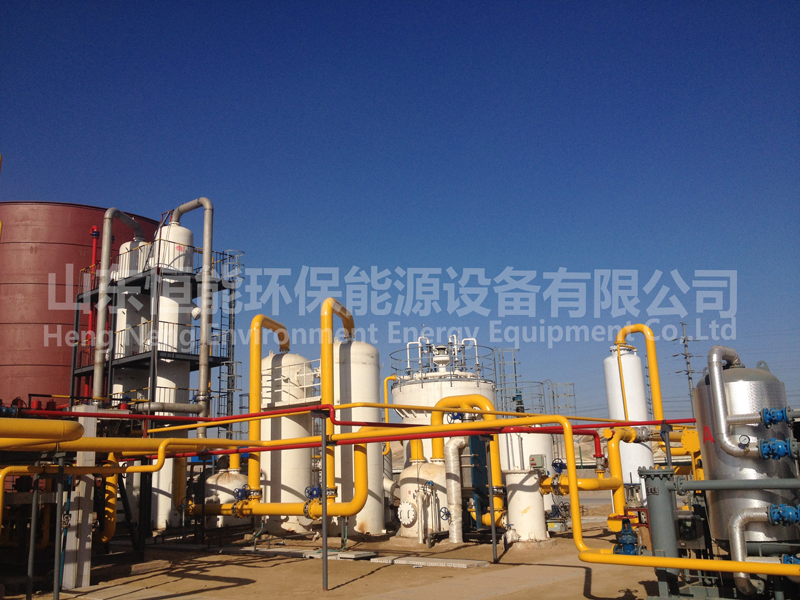欢迎进入山东恒能环保能源设备有限公司
欢迎进入山东恒能环保能源设备有限公司
在绿色能源转型的浪潮中,膜分离技术以其高效、节能的特性,成为沼气提纯领域的重要突破。该技术利用气体组分在分离膜中渗透速率的差异,以压力差为驱动力,实现甲烷的高效纯化。随着材料科学的进步,高分子膜、无机膜及复合膜的创新应用,为沼气提纯提供了更高效、更稳定的解决方案。然而,在实际工程中,温降效应、膜材料塑化等问题仍需攻克。本文将深入探讨膜分离技术的原理、材料选择及工程挑战,为沼气资源化利用提供科学参考。
In the wave of green energy transformation, membrane separation technology has become an important breakthrough in the field of biogas purification due to its high efficiency and energy-saving characteristics. This technology utilizes the difference in permeation rate of gas components in the separation membrane, driven by pressure difference, to achieve efficient purification of methane (CH?). With the advancement of materials science, innovative applications of polymer membranes, inorganic membranes, and composite membranes have provided more efficient and stable solutions for biogas purification. However, in practical engineering, issues such as temperature drop effect and plasticization of membrane materials still need to be overcome. This article will delve into the principles, material selection, and engineering challenges of membrane separation technology, providing scientific references for the utilization of biogas resources.
膜技术被誉为21世纪工业技术革新中的关键技术,沼气膜分离技术原理,通过利用沼气中各组分在气体分离膜中渗透速率的差异,以压力差为驱动力,实现CH4的纯化分离。
Membrane technology is known as a key technology in industrial technological innovation in the 21st century. The principle of biogas membrane separation technology is to purify and separate CH4 by utilizing the differences in permeation rates of various components in biogas in gas separation membranes, driven by pressure differences.
气体分离膜材料主要分为高分子材料、无机材料以及高分子-无机复合材料三大类别。其中,高分子膜材料如聚二甲基硅氧烷(PDMS)、聚砜(PSF)等,因其独特的化学性质和渗透性,在沼气膜分离中扮演着重要角色。而无机膜,如陶瓷膜、微孔玻璃等,则以其高强度和稳定性著称。
Gas separation membrane materials are mainly divided into three categories: polymer materials, inorganic materials, and polymer inorganic composite materials. Among them, polymer membrane materials such as polydimethylsiloxane (PDMS) and polysulfone (PSF) play an important role in biogas membrane separation due to their unique chemical properties and permeability. Inorganic membranes, such as ceramic membranes and microporous glass, are known for their high strength and stability.
膜的性能评估主要依据渗透性和选择性。研究表明,多数高分子膜存在渗透性与选择性相互制约的情况,即渗透性优异者,其选择性往往较差,反之亦然。然而,通过膜材料的优化设计,可以在一定程度上改善这种权衡关系,从而提高沼气膜分离的效率。
The performance evaluation of membranes is mainly based on permeability and selectivity. Research has shown that most polymer membranes have a mutual constraint between permeability and selectivity, where those with excellent permeability often have poor selectivity, and vice versa. However, by optimizing the design of membrane materials, this trade-off relationship can be improved to some extent, thereby enhancing the efficiency of biogas membrane separation.

在沼气提纯领域,聚酰胺膜和EC膜是备受推崇的高分子膜材料。然而,EC膜因对水分敏感,若未经适当前处理,则不适用于沼气分离。沼气分离过程中,面临H2S、H2O以及高压力等多重挑战,因此所选用的膜材料必须具备对这些气体的化学耐受能力,并能承受超过25 bar的压力和50℃以上的高温。
In the field of biogas purification, polyamide membrane and EC membrane are highly regarded polymer membrane materials. However, EC membranes are sensitive to moisture and are not suitable for biogas separation without appropriate treatment. In the process of biogas separation, multiple challenges such as H2S, H2O, and high pressure are faced. Therefore, the selected membrane material must have chemical resistance to these gases and be able to withstand pressures exceeding 25 bar and high temperatures above 50 ℃.
气体分离膜元件主要分为中空纤维元件、螺旋卷元件和封套式元件三类,其中前两种因堆积密度高而更受青睐。单一膜组件难以达到高CH4含量的提纯效果,且存在CH4流失率大的问题,因此在实际工程中,常采用多组膜组件串联的方式。
Gas separation membrane components are mainly divided into three categories: hollow fiber components, spiral coil components, and envelope components, among which the first two are more favored due to their high packing density. A single membrane module is difficult to achieve high CH4 content purification effect, and there is a problem of high CH4 loss rate. Therefore, in practical engineering, multiple membrane modules are often connected in series.
应用膜分离方法提纯沼气时,需关注两大问题。首先是温降问题,膜分离设备运行过程中产生的焦尔–汤姆逊效应会导致膜两侧气体显著降温,进而影响气体的热动力学特性和传质特性,使膜的渗透性降低。其次是膜的增塑化问题,高压条件下CO2可能引发高分子膜增塑化,导致渗透系数上升、选择性严重下降。因此,在选择膜材料时,应优先考量材料的高选择性和抗塑化性。
When using membrane separation methods to purify biogas, two major issues need to be addressed. Firstly, there is the issue of temperature drop. The Joule Thomson effect generated during the operation of membrane separation equipment can significantly cool the gas on both sides of the membrane, thereby affecting the thermodynamic and mass transfer properties of the gas and reducing the permeability of the membrane. Secondly, there is the issue of membrane plasticization. Under high pressure conditions, CO2 may cause plasticization of polymer membranes, leading to an increase in permeability coefficient and a severe decrease in selectivity. Therefore, when selecting membrane materials, priority should be given to their high selectivity and resistance to plasticization.
膜分离技术为沼气提纯提供了高效、环保的路径,但其性能优化仍面临材料选择与工程应用的双重挑战。从高分子膜的化学耐受性到无机膜的机械稳定性,从多级串联工艺到抗塑化设计,每一步创新都在推动沼气提纯技术的进步。未来,随着高性能膜材料的研发与工艺的完善,膜分离技术有望在沼气净化、碳捕集等领域发挥更大作用,为清洁能源的发展注入新动力。选择适配的膜技术与工艺,将成为实现沼气高值化利用的关键。
Membrane separation technology provides an efficient and environmentally friendly path for biogas purification, but its performance optimization still faces dual challenges in material selection and engineering applications. From the chemical resistance of polymer membranes to the mechanical stability of inorganic membranes, from multi-stage series processes to anti plasticizing designs, every innovation step is driving the progress of biogas purification technology. In the future, with the development of high-performance membrane materials and the improvement of processes, membrane separation technology is expected to play a greater role in areas such as biogas purification and carbon capture, injecting new impetus into the development of clean energy. Choosing the appropriate membrane technology and process will be the key to achieving high-value utilization of biogas.
本文由沼气提纯友情奉献.更多有关的知识请点击:https://www.hneee.net我们将会对您提出的疑问进行详细的解答,欢迎您登录网站留言.
This article is a friendly contribution from biogas purification For more information, please click: https://www.hneee.net We will provide detailed answers to your questions. You are welcome to log in to our website and leave a message